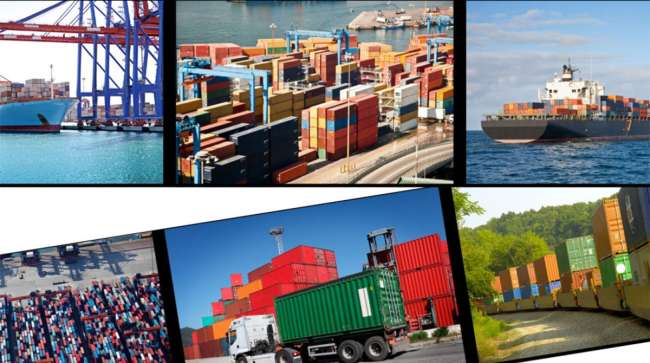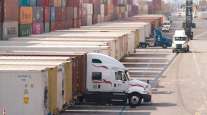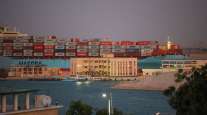Senior Reporter
FMC Commissioner Calls for Transparency in Shipping Industry

[Stay on top of transportation news: Get TTNews in your inbox.]
Federal Maritime Commissioner Carl Bentzel believes that the port and large cargo bottlenecks that occurred during the peak of the coronavirus pandemic during 2021 and 2022 must be avoided during future emergencies.
In a wide-ranging after-incident study, called the Maritime Transportation Data Initiative, Bentzel explains changes he believes are urgently needed, especially when it comes to sharing data among shipping companies and others moving freight.
“The intent of the recommendations contained in this report is not to require the change of individual business practices or to require new information services or systems,” Bentzel wrote. “The recommendations are aimed at harnessing existing information systems to maximize the value that can be provided by achieving real-time information and harmonizing content.”
Bentzel said he and his staff at FMC held 18 public meetings and discussed supply chain issues with more than 80 experts during the last year to compile the report.

Bentzel
“The recommendations focus on critical operational events in the intermodal transportation delivery system and establish real-time position and estimated arrival times for container shipments, harmonization of status of cargo while in storage at terminals, and proposals to establish information-sharing practices more effectively for the industry,” Bentzel said. “Ultimately, an updated and more transparent data-sharing practice for international shipping will benefit intermodal transportation service providers, U.S. importers, exporters and the U.S. public by achieving greater efficiency.”
During the peak of the freight backlog, the ports of Los Angeles and Long Beach — the nation’s largest, respectively — had more than 100 cargo ships waiting in San Pedro Bay for weeks to get a berth to be unloaded. Shipping companies saw their income and revenue soar and it actually became profitable for those carriers to turn around once the cargo was unloaded in Southern California, to return to Asia empty rather than continue north to Oakland, which saw its freight volume significantly decline.
On the East Coast, the Port of Savannah and others saw their container volume increase by more than 30% year-over-year as shippers looked to get urgently needed cargo into the United States as quickly as possible.
As the economy slows, freight volumes are returning to prepandemic levels at facilities on both the East and West Coast.
The nation’s railroads and trucking industry were also not immune to the supply chain bottlenecks. Several Class I rail carriers experienced severe labor shortages; two railroads imposed freight embargoes on freight coming out of Los Angeles and Long Beach causing huge delays at numerous locations along the supply chain; and ports and the critical railroad hub in Chicago experienced the worse bottlenecks in years.
For the trucking industry, the pandemic caused both spot and contract rates to soar, as the shortage of drivers and the high volume of freight in 2021 and 2022 helped push income levels steadily upward.
But now, as the economy slows and freight volumes return to normal, Bentzel says the pause will give transportation officials an opportunity to look to the future and develop a better strategy going forward. He believes information is the key to improving the overall process.
“The movement of a container carrying millions of dollars of cargo has a delivery span from overseas origin to domestic destination that is on average of one to two months’ time. Throughout this movement there are several ‘black hole’ moments. This loss of cargo visibility can set off a chain reaction of chaos within the supply chain,” Bentzel said. “I like to contrast this with what happens when I order a $10 pizza delivered. In that transaction, my local restaurant provides me an order confirmation, lets me know when my pizza is being cooked, tells me when the pizza goes out for delivery, its status while it is in transit (often via GPS), when the driver is approaching my house, and sometimes I even receive a picture confirming delivery.”

This special "Inside the List" episode features the Transport Topics 2023 Top 100 largest logistics companies. Hear the program above and at RoadSigns.TTNews.com.
Bentzel says supply chains are in better shape now than they were more than three years ago, in part because Congress passed, then President Joe Biden signed into law, the Ocean Shipping Reform Act, which will also give FMC more tools to oversee the ocean shipping industry.
But he believes maritime transportation data should be on open-facing platforms where freight can be tracked and located, the same way as the pizza he cited can be tracked from the oven to the delivery driver to your front door.
“Beneficial cargo owners (BCOs) and other consumers of intermodal carriage almost uniformly complained about the challenge of getting the most accurate information to use for pickup, delivery and receipt of cargo,” he said. “For instance, many BCOs/consignees complained about misinformation on status of cargo availability for pickup requests made of ocean carriers, ultimately causing trucking assets to be turned away from a terminal because of inaccurate reporting of container availability status.”
Want more news? Listen to today's daily briefing below or go here for more info:




